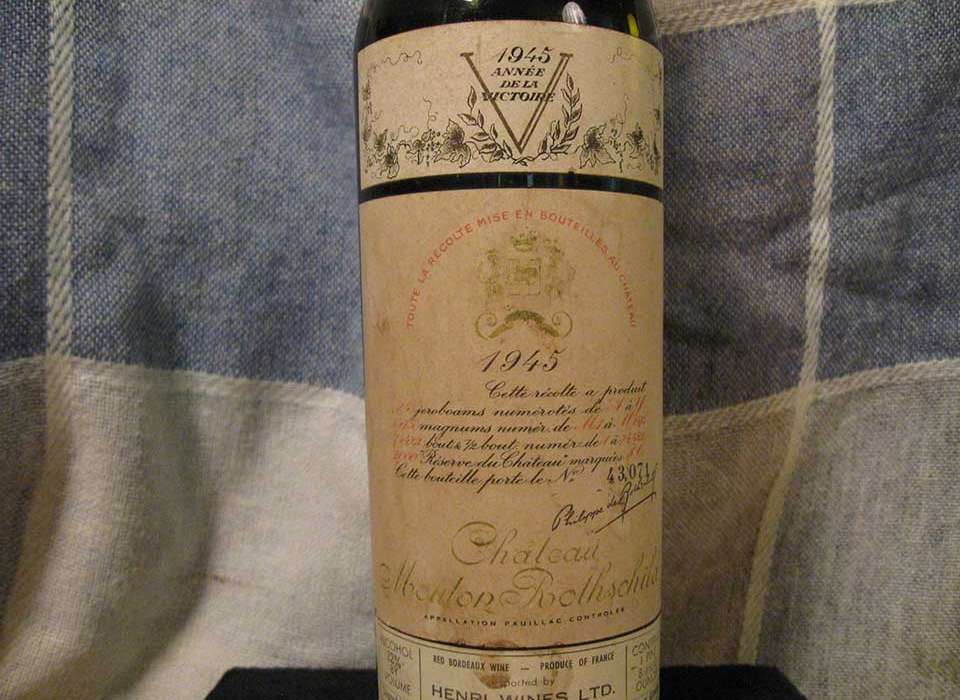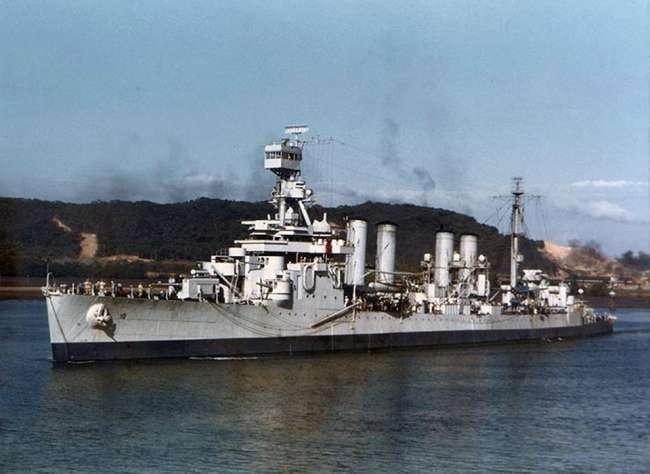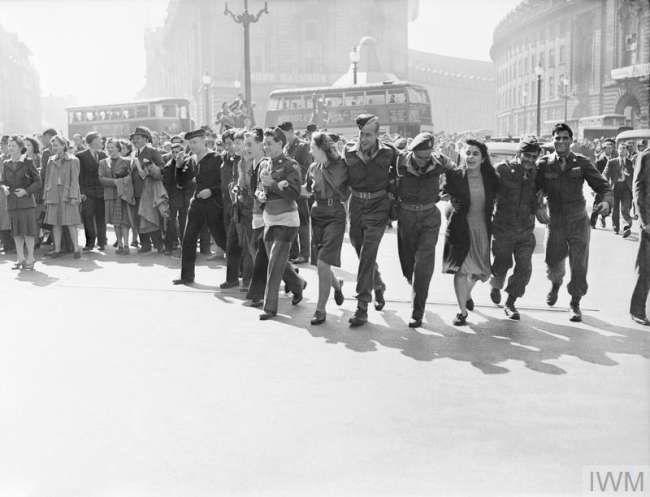One of the many interesting objects in the Museum’s Collection is a bottle of 1945 Chateau Mouton Rothschild, a red wine blend from Bordeaux, France. (Gift of Steve Simmons, 2017. 354.001.) This particular wine, if found on the open market, ranges from approximately $14,000 to $20,000. The two questions that spring into most people’s minds immediately are a) why would anyone pay that much for a single bottle of wine, and b) is the wine still drinkable?
The short answers are that a) you would possess a part of history that drinks beautifully, and b) maybe.
Chateau Mouton Rothschild is one of the First Growth wines of Bordeaux in southwest France. The other First Growth Bordeaux of today are Lafite Rothschild, Château Latour, Château Margaux, and Château Haut-Brion.
Allowed Bordeaux red wine grapes are Merlot, Cabernet Sauvignon, Cabernet Franc, and a small amount of Petit Verdot, Malbec, and Carménère. Today, Château Mouton Rothschild has 222 acres made up of Cabernet Sauvignon (81 percent), Merlot (15 percent), Cabernet Franc (3 percent) and Petit Verdot (1 percent.) Mouton is today named a “First Growth” under The Bordeaux Wine Official Classification of 1855. Napoleon III requested a classification system for France’s best Bordeaux wines. The wines were ranked according to a château’s reputation and trading price. Unfortunately, for reasons that are not clear but were apparently political, Mouton was placed as a Second Growth in 1855, still an honor but deeply upsetting to the Rothschild family.
Vintages are important in Bordeaux, as the weather can be much less predictable than some other regions. And it was an odd twist of history and luck that both 1918 and 1945 happened to be two of the greatest vintages in Bordeaux of the 20th century. Although almost every chateau in Bordeaux produced a good wine, the 1st Growths shone and the consensus among critics was that Mouton was the star of the vintage. Michael Broadbent, a leading Master of Wine, praised the ’45 Mouton as “simply unmistakable” and Decanter Magazine honored Mouton as one of the Legend wines of the twentieth century.
The 1945 Mouton is historically interesting for many reasons. Baron Phillipe Rothschild, the owner of the chateau since 1922, was an art lover and he experimented with using artists to create a label for a particular vintage, first in 1924. For the 1945 label, the Baron chose a relatively unknown French artist who created the distinctive “V for Victory” label that distinguishes Mouton from other wines of the vintage.
The estate itself suffered during the war as it was occupied by the Wehrmacht and used as a headquarters. Rothschild, being Jewish, fled to England during the war but was able to return in time for the 1945 harvest. The 1945 harvest was a smaller one but the grapes had become intensely ripe. Of course, there was also the emotional component to this particular vintage as it was the vintage of the year Germany was defeated, and the war and years of suffering had ended.
Thanks to the massive success of the vintage and the 1945 label, the Baron decided that from 1946 on he would commission an artist each year to create a label for each vintage. Among the artists who have provided art for the labels are Kandinsky, Joan Miro, Jean Cocteau, Salvador Dali, Marc Chagall, Pablo Picasso, and Andy Warhol.
There is one more part of the story that turns out well for the Baron and Mouton. In 1973, after decades of producing excellent wine and lobbying the Ministry of Agriculture, Mouton was elevated from Second to First Growth. Then Minister and future President of France, Jacques Chirac, signed the order. This was only the second time that the 1855 Classification had been changed, and the first change was relatively minor. Prior to 1973, Mouton Rothschild’s motto was Premier ne puis, second ne daigne, Mouton suis. (“First, I cannot be. Second, I do not deign to be. Mouton I am.”) After that year it became: Premier je suis, Second je fus, Mouton ne change. (“First, I am. Second, I used to be. Mouton does not change.”)
Finally, is that bottle of 1945 Mouton Rothschild still drinkable? A carefully stored bottle is apparently drinking reasonably well as Mouton is a wine that can take decades to mature. A bottle stored on its side and kept at 55 degrees F may still have life in it. A magnum (double bottle or 1.5 litres) or other “large format” bottles last longer than the usual 750ml bottle. Jancis Robinson, OBE, MW, another leading Master of Wine tasted a ’45 Mouton in September, 2019 and gave it 19 out of 20 points, calling it the “Essence of ripe claret.” Wine Advocate’s Lisa Perrotti-Brown gave the wine 100 points in October 2019:
“The overall character is paradoxical: at once profoundly mature and yet so jaw-droppingly youthful. If this finish does not bring a tear to your eyes, nothing will.”
Lisa Perrotti-Brown
The Museum celebrates “The War That Changed the World” and our bottle of 1945 Chateau Mouton Rothschild is yet another artifact that symbolizes the changes, both great and small, that swept the post war world.
Further Reading:
The Oxford Companion to Wine, Jancis Robinson OBE, MW. 4th Edition (2015)
Wine Legend: Château Mouton Rothschild 1945
Château Mouton Rothschild labels
Château Mouton Rothschild Label Art
Château Mouton Rothschild 1924
Château Mouton Rothschild 1945
Walter Wolf III
Walter Wolf joined the Museum in October 2019 as the Museum’s first intellectual property Rights Manager in the Curatorial Department. Walter has a Bachelor’s degree in Modern European History and a Juris Doctor degree in law. He also has a certificate in Espionage and Covert Operations from the University of New Orleans.
Cite this article:
MLA Citation:
APA Citation:
Chicago Style Citation:


![Max Fuchs, New York City cantor, sings as Rabbi Sydney [sic] Lefkowitz, Richmond, VA, conducts the first Jewish services from Germany.](/sites/default/files/styles/max_650x650/public/2025-10/image1.jpg)






